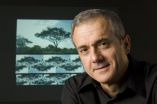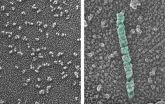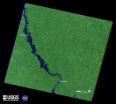(Press-News.org) JACKSON, Miss. – A group of researchers from the University of Oxford, Harvard Medical School and the University of Mississippi Medical Center has constructed the world's most detailed genetic map, a tool scientists can use to better understand the roots of disease and how DNA is passed generationally to create diversity in the human species.
About 5,000 Jackson-area volunteers were included in a group of nearly 30,000 African-Americans whose genetic information the scientists used to create the map.
The map pinpoints genome locations where people splice together DNA from their mothers and fathers to produce sperm or eggs. That process, known as recombination, mixes DNA from the person's parents and passes it on to his or her children.
Almost every prior genetic map was developed in people of European ancestry. The new map is the first built in African-Americans.
"The world's best genetic map is now built in African-Americans," said David Reich, professor of genetics at Harvard Medical School, who co-led the study with Simon Myers, a lecturer in statistics at the University of Oxford. "This map, built in 30,000 African-Americans who are from studies of heart disease and cancer, has a resolution so high it is now the world's most accurate map."
The findings will be published in the July 21 edition of Nature.
Dr. James Wilson, UMMC professor of medicine and the study's coordinator, said the map holds promise for both broad, genome-wide applications and narrowly focused, single-disease research.
"The map will be helpful in finding the genetic roots of any disease that's affected by inheritance – which is virtually every disease," he said.
For example, studies have shown certain diseases, such as hypertension, affect African-Americans at greater rates than whites, even with other variables like age, weight and socioeconomic level accounted for. The map could be used to better understand why.
A surprise was that the map turned out to be different than those based on people of European and other non-African ancestries.
"The landscape of recombination has shifted in African-Americans compared with Europeans," said Anjali Hinch, the study's first author and a post-graduate student at the Oxford University's Wellcome Trust Centrefor Human Genetics.
Wilson said the African-American genome has become distinct because of recombination in the U.S. during the past two to three centuries.
"African-Americans are a genetically distinguishable group from other continental populations," he said. "African-Americans differ from their African ancestors in that most of them also have genes from European ancestors."
The researchers knew that going into the project. But once they analyzed the breakpoints where recombination occurs in African-American genomes, an unexpected difference appeared.
"Over half of African-Americans carry a version of the biological machinery for recombination that is different to that in Europeans. As a result, African-Americans experience recombination where it almost never occurs in Europeans," Myers said.
Scientists have only recently begun to explore the genetic differences between individuals and populations — and the roles those differences play in human health. In that respect, the first draft of the human genome, completed a decade ago, was only a starting point for understanding the genetic origins of disease.
As researchers begin to parse those differences, a crucial tool is a genetic map, as it determines how some groups of genetic differences tend to be inherited together. Recombination, together with mutation, accounts for all the genetic (and thus physical) variety we see within species. But while mutation refers to the errors introduced into single locations within genomes when cells divide, recombination refers to the process by which huge chunks of chromosomes are stitched together during sexual reproduction.
A key to the success of genetic maps is that this stitching occurs only at specific locations in the genome. In a landmark set of papers, Myers and his colleagues previously identified a particular DNA code, or motif, that attracted the recombination machinery. Knowing the motif, a string of 13 DNA letters, researchers could zero in on the exact locations where recombination typically occurred—the "recombination hotspots."
"When recombination goes wrong, it's known that this can lead to mutations causing congenital diseases, for example diseases like Charcot-Marie-Tooth disease, or certain anemias. We found the same 13-base motif marking many of these disease-mutation sites," said Myers.
Reich, who is also a senior associate member of the Broad Institute, said the places in the genome where there are recombination hotspots can also be disease hotspots.
"Charting recombination hotspots can thus bring us to the places in the genome that cause disease," he said.
The researchers discovered that the 13 base-pair motif responsible for many hotspots in Europeans accounts for only two-thirds as much recombination in African-Americans. They connected the remaining third to a new motif of 17 base pairs, which is recognized by a version of the recombinational machinery that occurs almost exclusively in people of African ancestry.
These findings are expected to help researchers understand the roots of congenital conditions that occur more often in African-Americans (due to mutations at the hotspots that are more common in African-Americans), and also to help discover new disease genes in all populations, because of the ability to map these genes more precisely.
The new map is so accurate specifically because so many African-Americans have both African and European genes, due to racial mixing during the last couple of hundred years. Reich and Myers are experts in analyzing genetic data to reconstruct the mosaic of regions of African and European genetic ancestry in DNA of modern African-Americans.
Using a computer program Reich and Myers wrote specifically to sort the massive amounts of data, Hinch identified places in the genomes of the 30,000 people where switches occurred between African and European ancestry, detecting about 70 per person. These switches correspond to recombination events in the last couple of hundred years, resulting in the more than 2 million recombination events that the researchers used to build the map.
The study was only possible because of collaboration from 81 co-authors from many institutions, using DNA samples from five large studies that had previously been carried out to study common diseases such as heart disease and cancer, funded by the National Institutes of Health, the Department of Defense, and many private foundations.
"All the co-authors worked together in an incredibly collegial way to put together the enormous set of samples and high quality genetic data that made this study a success," Wilson said.
###
The analytic work for this study was supported by a nearly $1 million grant to Wilson at UMMC from the National Institute of General Medicine through the American Recovery and Reinvestment Act.
The recombination map is available at http://www.well.ox.ac.uk/~anjali/AAmap/
Acknowledgements
The almost 30,000 African-Americans whose DNA was analyzed for this project were participants in five large studies:
The Candidate Gene Association Resource (CARe) is a consortium of nine observational studies of cardiovascular disease and related traits. The consortium includes two Mississippi-based population studies: Atherosclerosis Risk in Communities (ARIC) Study and the Jackson Heart Study. The CARe consortium is supported by the National Heart, Lung, and Blood Institute and diverse other grants.
The African American Breast Cancer Consortium (AABCC) is a consortium of 8 studies of women with and without breast cancer, supported by the National Cancer Institute and diverse other grants.
The African American Prostate Cancer Consortium (AAPCC) is a consortium of 10 studies of men with and without prostate cancer, supported by the National Cancer Institute and diverse other grants.
The African American Lung Cancer Consortium (AALCC) is a consortium of 7 studies of people with and without lung cancer, supported by the National Cancer Institute and diverse other grants.
Many samples also come from the Children's Hospital of Philadelphia (CHOP), which has established a biobank for Philadelphia children to facilitate disease gene discovery.
For a complete list of institutions and granting agencies that supported this work, contact David Cameron at David_Cameron@hms.harvard.edu.
The University of Mississippi Medical Center, located in Jackson, is the state's only academic medical center. University of Mississippi Health Care represents the clinical programs of the Medical Center and includes University Hospitals and Health System and University Physicians, the faculty group practice. UMMC encompasses five health science schools, including medicine, nursing, health related professions, dentistry and graduate studies, as well as the site where University of Mississippi pharmacy students do their clinical training. The Medical Center's threefold mission is to educate tomorrow's health-care professionals, conduct innovative research to improve human health, and to provide the highest quality care available to the state's citizens. A major goal of the Medical Center is the improvement of the health of Mississippians and the elimination of health disparities. For more information, contact the Division of Public Affairs at 601-984-1100 or visit us on the Web at http://publicaffairs.umc.edu/
Genetic map of African-Americans to aid study of diseases, human evolution
2011-07-22
ELSE PRESS RELEASES FROM THIS DATE:
URMC researchers exploring keys to melanoma progression
2011-07-22
Melanoma is devastating on many fronts: rates are rising dramatically among young people, it is deadly if not caught early, and from a biological standpoint, the disease tends to adapt to even the most modern therapies, known as VEGF inhibitors. University of Rochester researchers, however, made an important discovery about proteins that underlie and stimulate the disease, opening the door for a more targeted treatment in the future.
This month in the journal Cancer Research, Lei Xu, Ph.D., assistant professor of Biomedical Genetics at the University of Rochester Medical ...
TGen, Virginia G. Piper Cancer Center studying new breast cancer drug
2011-07-22
SCOTTSDALE, Ariz. — July 20, 2011 — A new drug targeting the PI3K gene in patients with advanced breast cancer shows promising results in an early phase I investigational study conducted at Virginia G. Piper Cancer at Scottsdale Healthcare, according to a presentation by oncologist Dr. Daniel D. Von Hoff at the 47th annual meeting of the American Society of Clinical Oncology (ASCO).
The drug under investigation, GDC-0941, manufactured by Genentech Inc., South San Francisco, Calif., targets the PI3K gene, which is abnormal in about 20-30 percent of patients with advanced ...
Fast prediction of axon behavior
2011-07-22
Researchers at Case Western Reserve University have developed a computer modeling method to accurately predict how a peripheral nerve axon responds to electrical stimuli, slashing the complex work from an inhibitory weeks-long process to just a few seconds.
The method, which enables efficient evaluation of a nerve's response to millions of electrode designs, is an integral step toward building more accurate and capable electrodes to stimulate nerves and thereby enable people with paralysis or amputated limbs better control of movement.
To increase the accuracy of the ...
U of M researchers discover gene required to maintain male sex throughout life
2011-07-22
MINNEAPOLIS / ST. PAUL (July 20, 2011) – University of Minnesota Medical School and College of Biological Sciences researchers have made a key discovery showing that male sex must be maintained throughout life.
The research team, led by Drs. David Zarkower and Vivian Bardwell of the U of M Department of Genetics, Cell Biology and Development, found that removing an important male development gene, called Dmrt1, causes male cells in mouse testis to become female cells.
The findings are published online today in Nature.
In mammals, sex chromosomes (XX in female, XY ...
Research outlines math framework that could help convert 'junk' energy into useful power
2011-07-22
BUFFALO, N.Y. -- A University at Buffalo-led research team has developed a mathematical framework that could one day form the basis of technologies that turn road vibrations, airport runway noise and other "junk" energy into useful power.
The concept all begins with a granular system comprising a chain of equal-sized particles -- spheres, for instance -- that touch one another.
In a paper in Physical Review E this June, UB theoretical physicist Surajit Sen and colleagues describe how altering the shape of grain-to-grain contact areas between the particles dramatically ...
Survey: Killing of bin Laden worsened Americans' views of US Muslims
2011-07-22
COLUMBUS, Ohio – Instead of calming fears, the death of Osama bin Laden actually led more Americans to feel threatened by Muslims living in the United States, according to a new nationwide survey.
In the weeks following the U.S. military campaign that killed bin Laden, the head of the terrorist organization Al Qaeda, American attitudes toward Muslim Americans took a significant negative shift, results showed.
Americans found Muslims living in the United States more threatening after bin Laden's death, positive perceptions of Muslims plummeted, and those surveyed were ...
Seeing the S-curve in everything
2011-07-22
DURHAM, N.C. – Esses are everywhere.
From economic trends, population growth, the spread of cancer, or the adoption of new technology, certain patterns inevitably seem to emerge. A new technology, for example, begins with slow acceptance, followed by explosive growth, only to level off before "hitting the wall."
When plotted on graph, this pattern of growth takes the shape of an "S."
While this S-curve has long been recognized by economists and scientists, a Duke University professor believes that a theory he developed explains the reason for the prevalence of this ...
After the revolution: Groups vie for minds, votes of Egyptians
2011-07-22
Los Angeles, (July 2011) — Despite helping to push Hosni Mubarak and his regime from power, Egypt's liberals and pro-democracy activists are having trouble moving from revolution to politics, according to a recent article in the World Policy Journal (published by SAGE).
In this in-depth look at the Egyptian political landscape, the article's author, Jenna Krasjeki, examines various groups vying for influence and public support in the run-up to elections this fall. One common characteristic that Krasjeski notes is the lack of organization in the groups of young, liberal ...
Evolution provides clue to blood clotting
2011-07-22
A simple cut to the skin unleashes a complex cascade of chemistry to stem the flow of blood. Now, scientists at Washington University School of Medicine in St. Louis have used evolutionary clues to reveal how a key clotting protein assembles. The finding sheds new light on common bleeding disorders.
The long tube-shaped protein with a vital role in blood clotting is called von Willebrand Factor (VWF). Made in cells that form the inner lining of blood vessels, VWF circulates in the blood seeking out sites of injury. When it finds them, its helical tube unfurls to catch ...
Landsat satellites track continued Missouri River flooding
2011-07-22
Flooding along the Missouri River continues as shown in recent Landsat satellite images of the Nebraska and Iowa border. Heavy rains and snowmelt have caused the river to remain above flood stage for an extended period.
A Landsat 5 image of the area from May 5, 2011 shows normal flow. In contrast, a Landsat 7 image from July 17 depicts flood conditions in the same location.
A national overview map of streamflow provided by U.S. Geological Survey (USGS) WaterWatch graphically portrays the immense geographic extent of flooding in the Missouri River basin.
Monitoring ...



